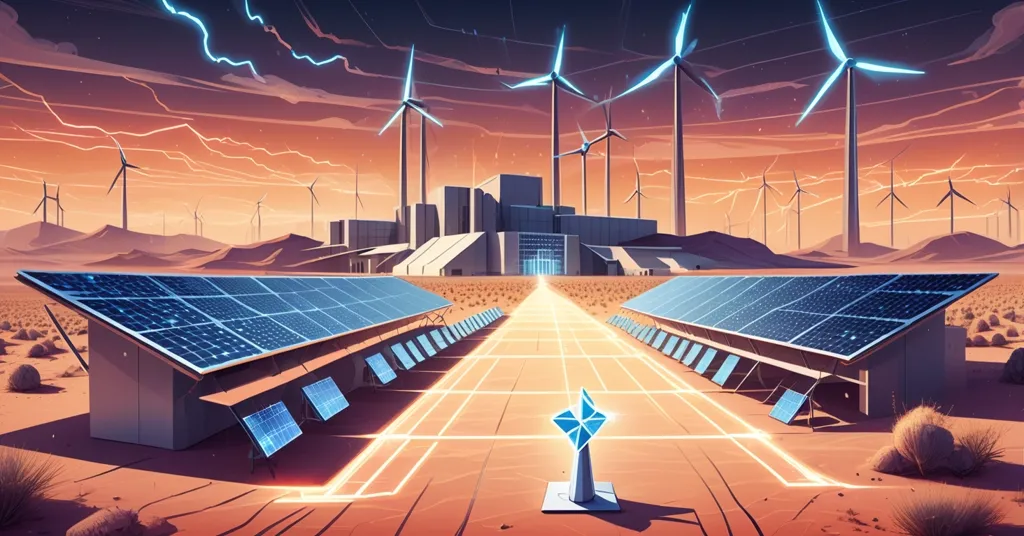Google’s $40B Texas Data Center Push: AI Boom Meets Crypto Energy Clash

Google’s $40 Billion Texas Gambit: Data Centers, AI, and Crypto’s Double-Edged Sword
Google, through its parent company Alphabet Inc., has unveiled a jaw-dropping $40 billion plan to construct three new data centers in Texas, signaling a major escalation in the race for tech supremacy. This investment, set to unfold through 2027, isn’t just about expanding server farms—it’s a strategic play in artificial intelligence (AI), cloud computing, and potentially the broader landscape of decentralized technologies like Bitcoin and blockchain that we hold dear.
- Colossal Investment: $40 billion for three data centers in Texas by 2027.
- Key Locations: Facilities in Armstrong and Haskell Counties, with a nod to sustainable energy.
- Wider Impact: Jobs, training, and implications for blockchain’s future in the region.
Breaking Down the Investment: What’s at Stake?
Google’s announcement, delivered by Alphabet CEO Sundar Pichai at an event near Dallas, lays out a vision of growth with tangible benefits. The data centers will be split between Armstrong County in the Texas Panhandle and two sites in Haskell County near Abilene. One of the Haskell facilities stands out with its integration of a solar and battery energy storage plant—a move to lessen the burden on Texas’ notoriously strained power grid. For the uninitiated, data centers are the hidden engines of our digital world. Think of them as giant internet warehouses, packed with servers that store your data, power your apps, and increasingly run the mind-bending algorithms behind generative AI tools (those are programs that create content like text or images from scratch). These facilities consume electricity like a fleet of monster trucks, making energy solutions a critical piece of the puzzle.
Pichai framed this as more than a tech project, emphasizing its human and economic upside.
“This investment will create thousands of jobs, offer skills training for college students and electrical apprentices, and speed up energy affordability projects across Texas,”
he declared, positioning Google as a partner in local development. Through Google.org’s AI Opportunity Fund, the company is rolling out training programs to equip students and workers with skills for the digital age. Alphabet’s stock reflected investor confidence, climbing 1.7% in after-hours trading to close at $276.41 in New York. But beyond the numbers, this is part of a larger $90 billion capital expenditure forecast for 2023, with Google pouring cash into servers, custom chips, and data centers to stay ahead in the AI arms race—a digital showdown akin to the Cold War’s space race.
Why Texas? A Tech Haven in the Making
Texas isn’t a random choice for Google; it’s a calculated one. The state boasts some of the lowest energy costs in the nation, thanks to a deregulated power market that can save companies up to 30% compared to tech hubs like California. Couple that with endless open land and a state government that’s practically begging for business with fast-tracked permits and minimal red tape, and you’ve got a tech utopia on paper. Governor Greg Abbott has been outspoken about Texas’ ambitions, touting it as the future nerve center for AI infrastructure, with policies designed to keep companies like Google moving at lightning speed. For more details on this massive undertaking, check out the full scope of Google’s $40 billion Texas data center expansion.
For those new to this space, cheap energy and land are gold for data centers because of their sheer operational demands. These aren’t just buildings; they’re power-hungry beasts that need constant electricity to keep servers cool and running 24/7. Texas, already a leader in wind energy and with growing solar potential, offers a unique edge over coastal states where costs and space are prohibitive. This has turned the Lone Star State into a magnet not just for Google, but for a whole posse of tech giants looking to stake their claim.
The Competitive Landscape: Tech Titans Converge on Texas
Google isn’t riding solo in this Texas tech stampede. The competition is cutthroat, with other heavyweights making massive bets on the state. Here’s a quick rundown of who’s in the game:
- Anthropic: Planning a $50 billion investment in US data centers, with Texas and New York on the list.
- OpenAI, Oracle, and SoftBank: Kicked off the Stargate project with a data center in Abilene, with more planned.
- Meta Platforms: Building a gigawatt-capacity data center, enough to power 750,000 homes.
- Microsoft: Signed a nearly $10 billion, five-year deal for computing capacity in Texas.
- Fermi Inc.: Co-founded by former Texas Governor Rick Perry, planning four nuclear power reactors for a private data center campus.
This frenzy isn’t just coincidence—it’s a testament to Texas’ strategic allure. But it also raises a question: is this concentration of tech power a strength or a looming vulnerability? If the state’s infrastructure or policies falter, the ripple effects could hit the entire industry hard. It’s a high-stakes poker game, and Texas is holding a lot of chips.
Crypto and Blockchain Implications: Boon or Bane?
Let’s pivot to our wheelhouse—how does this massive tech buildout intersect with Bitcoin, blockchain, and the decentralized future we’re rooting for? On the surface, there’s potential for synergy. Texas is already a hotspot for Bitcoin mining, with outfits like Riot Blockchain and Marathon Digital running sprawling operations drawn by the same dirt-cheap power that seduced Google. These data centers, with their sheer computational might, could indirectly support blockchain tech—imagine excess capacity being leased for mining or running Ethereum nodes during off-peak hours. For us Bitcoin maximalists, Texas’ energy landscape feels like a natural fit for keeping the network secure and humming, even if altcoins like Ethereum carve out niches with smart contracts and DeFi apps.
But here’s the flip side, and it’s a nasty one. Data centers are energy black holes, and Texas’ grid—managed by ERCOT (Electric Reliability Council of Texas)—has a track record of buckling under pressure. The 2021 winter storm left millions without power, and that’s just one of many stress tests the system has failed. Bitcoin mining already catches flak for straining local grids, and now Big Tech is muscling in with deeper pockets. If Google and crypto miners are scrapping over the same limited megawatts, guess who’s likely to come out on top? Hint: it’s not the independent miner with a shed full of ASICs. Worse, as public scrutiny over sustainability grows, Google’s solar and battery storage efforts in Haskell County—while a promising start—could set a bar that crypto struggles to meet. Regulators might start cracking down harder on power-hungry industries, and Bitcoin’s proof-of-work could be the first scapegoat.
Playing devil’s advocate for a moment, there’s a deeper tension at play. Google’s data centers are centralized monoliths, the polar opposite of the distributed, freedom-driven ethos of blockchain. If Texas’ tech future is molded by Big Tech’s priorities—profit and control over autonomy and privacy—where does that leave decentralization? Sure, we might gain short-term infrastructure benefits, but are we risking a long-term erosion of the principles we fight for? It’s a gut check for anyone who believes in disrupting the status quo through tech like Bitcoin.
Challenges on the Horizon: Grid Woes and Social Costs
While the economic upside of Google’s investment is undeniable, let’s not drink the Kool-Aid just yet. Texas’ power grid is a glaring weak spot. Beyond the infamous 2021 blackout, ERCOT has faced repeated criticism for insufficient capacity during peak demand, whether from scorching summers or brutal winters. Google’s renewable energy tie-in at Haskell is a step forward, but it’s nowhere near enough to offset the colossal demand these data centers will create. How much of the facility’s power will actually come from solar, and is there transparency on these goals? Without hard data, it’s tough to gauge if this is genuine progress or greenwashing window dressing.
Then there’s the social impact. Thousands of jobs sound fantastic, but many will demand specialized skills—data engineers, AI specialists—that the average local worker might not have without serious upskilling. Google’s training initiatives are a plus, but they won’t cover everyone. Meanwhile, Big Tech’s arrival often inflates living costs. Housing, utilities, and everyday expenses could spike in areas like Haskell and Armstrong Counties, potentially displacing longtime residents or pricing them out. Is Texas ready for this kind of rapid gentrification, or will the economic boom come with a hidden human toll? These are questions that need answers as the state transforms.
Future Outlook: Acceleration with Caveats
From the lens of effective accelerationism—the idea that pushing tech forward fast can unlock radical change—Google’s Texas play is a win. It’s infrastructure at scale, the kind of raw muscle that could propel AI, cloud services, and maybe even blockchain into the next decade. As champions of disruption, we can’t help but admire the sheer ambition. But acceleration doesn’t mean blind optimism. If Texas is to be the beating heart of both Big Tech and decentralized systems, it’ll need to solve its energy riddle and balance corporate giants with grassroots innovators. Otherwise, we risk a future where the Googles of the world dictate terms, and the dream of digital freedom gets sidelined.
Zooming out, this $40 billion bet is a microcosm of tech’s broader trajectory. Physical realities—land, power, politics—still underpin our digital aspirations, whether it’s hosting AI models or securing Bitcoin’s blockchain. Texas is the proving ground for whether innovation can coexist with sustainability and equity. If it can’t pull that off here, with all its built-in advantages, then where the hell can it? Let’s watch this space, because the stakes couldn’t be higher.
Key Questions and Takeaways
- What’s fueling Google’s $40 billion data center push in Texas?
Texas offers unmatched advantages—low energy costs, abundant land, and a business-friendly government—making it a prime spot for scaling AI and cloud infrastructure critical to tech’s future. - How could this impact Bitcoin and blockchain technology?
The infrastructure might bolster blockchain operations with shared resources, but energy competition and sustainability pressures could squeeze crypto, especially Bitcoin mining, in Texas’ crowded power market. - Can Texas’ grid handle Big Tech and crypto’s combined energy demands?
Not without upgrades—historical failures like the 2021 storm expose weaknesses, and while Google’s renewable initiatives help, they’re far from addressing the full capacity challenge. - Why are tech giants like Google, Meta, and Microsoft flocking to Texas?
The state’s cheap energy, deregulation, and political support create a perfect storm for infrastructure projects vital to AI, cloud, and potentially decentralized tech. - Does Google’s centralized model threaten crypto’s decentralized vision?
Possibly—while the infrastructure could aid blockchain in the near term, Big Tech’s dominance risks overshadowing the autonomy and privacy at the core of systems like Bitcoin.



